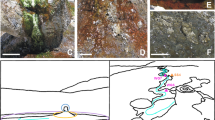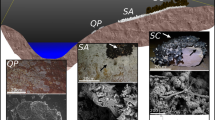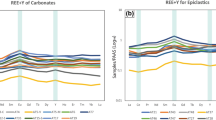Abstract
The endolithic environment, the pore space of rocks, is a ubiquitous habitat for microorganisms on the Earth1 and is an important target of the search for life elsewhere in the Solar System2. Photosynthetic, endolithic microbial communities commonly inhabit the outer millimetres to centimetres of all rocks exposed to the Earth's surface. In the most extreme terrestrial climates, such as hot and cold deserts, endolithic microorganisms are often the main form of life3,4,5. The endolithic microhabitat gives protection from intense solar radiation and desiccation, and it provides mineral nutrients, rock moisture and growth surfaces4,5. Here we describe the discovery and identification of the constituents of an extremely acidic (pH 1) endolithic microbial community inhabiting the pore space of rocks in the geothermal environment of Yellowstone National Park, USA. Subjected to silica mineralization, such endolithic communities constitute biomarkers that can become fossilized and potentially preserved in the geological record. Remnants of these communities could serve as biosignatures and provide important clues about ancient life associated with geothermal environments on the Earth or elsewhere in the Solar System.
This is a preview of subscription content, access via your institution
Access options
Subscribe to this journal
Receive 51 print issues and online access
$199.00 per year
only $3.90 per issue
Buy this article
- Purchase on Springer Link
- Instant access to full article PDF
Prices may be subject to local taxes which are calculated during checkout


Similar content being viewed by others
References
Golubic, S., Friedmann, E. I. & Schneider, J. The lithobiontic ecological niche, with special reference to microorganisms. J. Sedim. Petrol. 51, 475–478 (1981)
Hofmann, B. A. & Farmer, J. D. Filamentous fabrics in low-temperature mineral assemblages: are they fossil biomarkers? Implications for the search for a subsurface fossil record on the early Earth and Mars. Planet. Space Sci. 48, 1077–1086 (2000)
Friedmann, E. I. & Ocampo, R. Endolithic blue-green algae in dry valleys—primary producers in Antarctic desert ecosystem. Science 193, 1247–1249 (1976)
Friedmann, E. I. Endolithic microorganisms in the Antarctic cold desert. Science 215, 1045–1053 (1982)
Bell, R. A. Cryptoendolithic algae of hot semiarid lands and deserts. J. Phycol. 29, 133–139 (1993)
Gross, W., Kuver, J., Tischendorf, G., Bouchaala, N. & Busch, W. Cryptoendolithic growth of the red alga Galdieria sulphuraria in volcanic areas. Eur. J. Phycol. 33, 25–31 (1998)
Mosser, J. L., Misser, A. G. & Brock, T. D. Bacterial origin of sulfuric acid in geothermal habitats. Science 179, 1323–1324 (1973)
White, D. E., Hutchinson, R. A. & Keith, T. E. C. The Geology and Remarkable Thermal Activity of Norris Geyser Basin, Yellowstone National Park, Wyoming. (US Geol. Surv. Professional Paper no. 1456, Washington DC, 1988).
Cady, S. L. & Farmer, J. D. in Evolution of Hydrothermal Ecosystems on Earth (and Mars?) (eds Bock, G. R. & Goode, J. A.) 150–173 (Wiley, New York, 1996)
Asada, R. & Tazaki, K. Silica biomineralization of unicellular microbes under strongly acidic conditions. Can. Mineral. 39, 1–16 (2001)
Blank, C. E., Cady, S. L. & Pace, N. R. Microbial composition of near-boiling silica-depositing thermal springs throughout Yellowstone National Park. Appl. Environ. Microbiol. 68, 5123–5135 (2002)
Zierenberg, R. A. & Schiffman, P. Microbial control of silver mineralization at a sea-floor hydrothermal site on the northern Gorda Ridge. Nature 348, 155–157 (1990)
Cady, S. L., Farmer, J. D., Grotzinger, J. P., Schopf, J. W. & Steele, A. Morphological biosignatures and the search for life on Mars. Astrobiology 3, 351–368 (2003)
Farmer, J. D. & Des Marais, D. J. Exploring for a record of ancient Martian life. J. Geophys. Res. Planets 104, 26977–26995 (1999)
Banfield, J. F., Moreau, J. W., Chan, C. S., Welch, S. A. & Little, B. Mineralogical biosignatures and the search for life on Mars. Astrobiology 1, 447–465 (2001)
Des Marais, D. J. & Walter, M. R. Astrobiology: Exploring the origins, evolution, and distribution of life in the Universe. Annu. Rev. Ecol. Syst. 30, 397–420 (1999)
Pace, N. R. A molecular view of microbial diversity and the biosphere. Science 276, 734–740 (1997)
Stackebrandt, E. & Goebel, B. M. Taxonomic note: A place for DNA-DNA reassociation and 16S rRNA sequence analysis in the present species definition in bacteriology. Int. J. Syst. Bacteriol. 44, 846–849 (1994)
Iivanainen, E. K., Martikainen, P. J., Raisanen, M. L. & Katila, M. L. Mycobacteria in boreal coniferous forest soils. FEMS Microbiol. Ecol. 23, 325–332 (1997)
Spear, J. R., Walker, J. J., McCullem, T. M. & Pace, N. R. Hydrogen and bioenergetics in the Yellowstone geothermal ecosystem. Proc. Natl Acad. Sci. USA 102, 2555–2560 (2005)
Hall-Stoodley, L. & Lappin-Scott, H. Biofilm formation by the rapidly growing mycobacterial species Mycobacterium fortuitum . FEMS Microbiol. Lett. 168, 77–84 (1998)
Ascaso, C. & Wierzchos, J. The search for biomarkers and microbial fossils in Antarctic rock microhabitats. Geomicrobiol. J. 20, 439–450 (2003)
Schopf, J. W., Barghoorn, E. S., Maser, M. D. & Gordon, R. O. Electron microscopy of fossil bacteria two billion years old. Science 149, 1365–1367 (1965)
Walter, M. R. A hot spring analog for the depositional environment of Precambrian iron formations of the Lake Superior Region. Econ. Geol. 67, 965–980 (1972)
Christensen, P. R. et al. Morphology and composition of the surface of Mars: Mars Odyssey THEMIS results. Science 300, 2056–2061 (2003)
Doemel, W. N. & Brock, T. D. pH of very acid soils. Nature 229, 574 (1971)
St. Amand, A. L., Frank, D. N., De Groote, M. A. & Pace, N. R. Microscopic detection of Myocobacterium avium complex organisms in tissue with specific rRNA oligonucleotide probes. J. Clin. Microbiol. 4(43), (in the press)
Papineau, D., Walker, J. J., Mojzsis, S. J. & Pace, N. R. Composition and structure of microbial communities from stromatolites of Hamelin Pool in Shark Bay, Western Australia. Appl. Environ. Microbiol. (in the press)
Wierzchos, J. & Ascaso, C. Application of backscattered electron imaging to the study of the lichen rock interface. J. Microsc. 175, 54–59 (1994)
Frigaard, N. U., Larsen, K. L. & Cox, R. P. Spectrochromatography of photosynthetic pigments as a fingerprinting technique for microbial phototrophs. FEMS Microbiol. Ecol. 20, 69–77 (1996)
Acknowledgements
We thank K. Harris, D. Papineau, R. Ley, C. Rumbaitis-del Rio and the Pace laboratory members for discussion; H. Haesler, C. Hendrix and the staff of Yellowstone National Park for their assistance and discussion; J. Maresca and D. Bryant for high-performance liquid chromatography analysis of photosynthetic pigments; F. Luiszer and J. Drexler for chemical analysis and support for SEM; P. Boni and T. Giddings for sample preparation; H. Kleebe and G. Zito of the Colorado School of Mines for use of the BSE–SEM; and R. Castenholz and the CCMEE for cultures of Cyanidium spp. This research was supported by a grant from the NSF to N.R.P. and the University of Colorado Center for Astrobiology.
Author information
Authors and Affiliations
Corresponding author
Ethics declarations
Competing interests
The authors declare that they have no competing financial interests.
Rights and permissions
About this article
Cite this article
Walker, J., Spear, J. & Pace, N. Geobiology of a microbial endolithic community in the Yellowstone geothermal environment. Nature 434, 1011–1014 (2005). https://doi.org/10.1038/nature03447
Received:
Accepted:
Issue Date:
DOI: https://doi.org/10.1038/nature03447
This article is cited by
-
Hyperthermophile diversity microbes in the Calientes geothermal field, Tacna, Peru
Brazilian Journal of Microbiology (2023)
-
Orbit-to-ground framework to decode and predict biosignature patterns in terrestrial analogues
Nature Astronomy (2023)
-
Cancer vaccines from cryogenically silicified tumour cells functionalized with pathogen-associated molecular patterns
Nature Biomedical Engineering (2021)
-
Antarctica as a reservoir of planetary analogue environments
Extremophiles (2021)
-
Down to the bone: the role of overlooked endolithic microbiomes in reef coral health
The ISME Journal (2020)
Comments
By submitting a comment you agree to abide by our Terms and Community Guidelines. If you find something abusive or that does not comply with our terms or guidelines please flag it as inappropriate.



